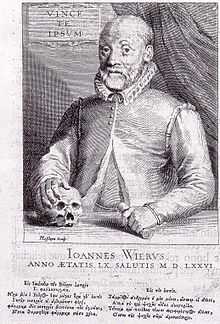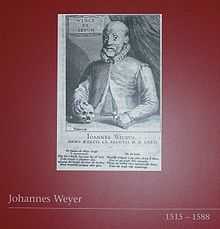Johann Weyer
| Johann Weyer | |
|---|---|
 Engraving by Pieter Holsteyn II, 1660 | |
| Born |
1515 Grave, Netherlands |
| Died |
24 February 1588 (aged 73) Tecklenburg |
| Other names | Jan Wier, Johan Wier, Johannes Wier, Jean Wier, Ioannes Wierus, Piscinarius |
| Occupation |
Physician, General occultist |
| Employer | Duke of Jülich-Cleves |

Johann Weyer (in Dutch Jan/Johan/Johannes Wier; in Latin Ioannes Wierus and Piscinarius) (1515 – 24 February 1588) was a Dutch physician, occultist and demonologist, disciple and follower of Heinrich Cornelius Agrippa. He was among the first to publish against the persecution of witches. His most influential work is De Praestigiis Daemonum et Incantationibus ac Venificiis (On the Illusions of the Demons and on Spells and Poisons, 1563).
Biography
Weyer was born in Grave, a small town in the Duchy of Brabant in the Habsburg Netherlands. He attended the Latin schools in 's-Hertogenbosch and Leuven and when he was about 14 years of age, he became a live-in student of Agrippa, in Antwerp. Agrippa had to leave Antwerp in 1532 and he and his student then settled in Bonn, under the protection of prince-bishop Hermann von Wied. After completing a work on demons in 1533, Agrippa died in 1535, during a trip to France. From 1534, Weyer studied medicine in Paris and later in Orléans (It appears unlikely that he obtained the title of Doctor through these studies). Subsequently, he practiced as a physician in his native Grave. In 1545, he was appointed town physician of Arnhem. In this capacity, he was asked for advice on witchcraft in a 1548 court case involving a fortune teller. In spite of a subsidy from emperor Charles V, Arnhem was no longer able to pay Weyer's salary in 1550 and Weyer moved to Cleves, where he became court doctor to duke William the Rich, through mediation by humanist Konrad Heresbach.[1] Here he published his major works on demons, magic, and witchcraft, in which he applied a sceptical medical view to reported wonders and supposed examples of magic or witchcraft. He retired from his post in 1578 and was succeeded by his son, Galenus Weyer. After retirement he completed a medical work on a subject unrelated to witchcraft. He died on 24 February 1588 at the age of 73 in Tecklenburg, while visiting somebody who had fallen ill. He was buried in the local churchyard, which is no longer extant.
Work and critical reception
Weyer's works include medical and moral works as well as his more famous critiques of magic and witchcraft:
- De Praestigiis Daemonum et Incantationibus ac Venificiis (On the Illusions of the Demons and on Spells and Poisons), 1563.
- Pseudomonarchia Daemonum (The False Kingdom of the Demons), an appendix to De Praestigiis Daemonum, 1577.
- "Medicarum Observationum rararum liber, 1567, (A book of medical observations on rare, hitherto undescribed diseases), translated into German as:
- "Artzney-Buch von etlichen biß anher unbekandten unnd unbeschriebenen Kranckheiten," 1580
- "De lamiis liber item de commentitiis jejuniis," 1577, (A book on witches together with a treatise on false fasting), translated into German as:
- "De Lamiis, Das ist: Von Teuffelsgespenst Zauberern und Gifftbereytern, kurtzer doch gründtlicher Bericht... 1586
- "De ira morbo," 1577. (On the disease of anger), translated into German as:
- "Vom Zorn, iracundiae antidotum ... : Buch. Von der gefehrlichen Kranckheit dem Zorn, und desselbigen philosophischer, und theologischer Cur oder Ertzney," 1585
- "De scorbuto epitome," 1564 (On scurvy)
- "Histoire Disputes et Discours des Illusions et Diables, des Magiciens Infame, Sorcieres et Empoisonneurs: des Ensorcelez et Demoniaques et de la Guerison D'Iceux: Item de la Punition que Meritent les Magiciens les Empoisonneurs et les Sorcieres,". 1579. 1885 translation printed aux Bureaux du Progres Medical, Paris France. Two volume set.
"About 40 people at Casale in Western Lombardy smeared the bolts of the town gates with an ointment to spread the plague. Those who touched the gates where infected and many died. The heirs of the dead and diseased had actually paid people at Casale to smear the gates in order to obtain their inheritances more quickly." -From The Deceptions of Demons, 1583
Weyer criticised the Malleus Maleficarum and the witch hunting by the Christian and Civil authorities; he is said to have been the first person that used the term "mentally ill" or melancholy to designate those women accused of practicing witchcraft.[2] In a time when witch trials and executions were just beginning to be common, he sought to derogate the law concerning witchcraft prosecution. He claimed that not only were examples of magic largely incredible but that the crime of witchcraft was literally impossible, so that anyone who confessed to the crime was likely to be suffering some mental disturbance (mainly "melancholy," which was at that time a very flexible category with many different symptoms).
Some scholars have said that Weyer intended to mock the concept of the hellish hierarchy that previous grimoires had established by writing those two books and entitling his catalogue of demons Pseudomonarchia Daemonum (The False Kingdom of the Demons).
Nevertheless, while he defended the idea that the Devil's power was not as strong as claimed by the orthodox Christian churches in De Praestigiis Daemonum, he defended also the idea that demons did have power and could appear before people who called upon them, creating illusions; but he commonly referred to magicians and not to witches when speaking about people who could create illusions, saying they were heretics who were using the Devil's power to do it, and when speaking on witches, he used the term mentally ill.[3]
Moreover, Weyer did not only write the catalogue of demons Pseudomonarchia Daemonum, but also gave their description and the conjurations to invoke them in the appropriate hour and in the name of God and the Trinity, not to create illusions but to oblige them to do the conjurer's will, as well as advice on how to avoid certain perils and tricks if the demon was reluctant to do what he was commanded or a liar. In addition, he wanted to abolish the prosecution of witches, and when speaking on those who invoke demons (which he called spirits) he carefully used the word exorcist.
Weyer never denied the existence of the Devil and a huge number of other demons of high and low order. His work was an inspiration for other occultists and demonologists, including an anonymous author who wrote the Lemegeton (The Lesser Key of Solomon). There were many editions of his books (written in Latin), especially Pseudomonarchia Daemonum, and several adaptations in English, including Reginald Scot's Discoverie of Witchcraft (1584).
Weyer's appeal for clemency for those accused of the crime of witchcraft was opposed later in the sixteenth century by the Swiss physician Thomas Erastus and the French legal theorist Jean Bodin.
Tributes

The church of Tecklenburg displays a plaque in memory of Weyer and in 1884 the town erected a tower in his honor, the Wierturm. The Dutch human rights organization for health workers is named the Johannes Wier Foundation after him. Alongside his tutor, Heinrich Cornelius Agrippa, he appears as a character in the video game Amnesia: The Dark Descent.
Family
Johan was the son of Agnes Rhordam and Theodorus (Dirk) Wier, a merchant of hops, coal and slate, who was a schepen of Grave in the 1520s. Dirk and Agnes Wier came from Zeeland and were closely acquainted with Maximiliaan van Egmond and Françoise de Lannoy, the future in-laws of William the Silent. Johan had two known siblings, Arnold Wier and the mystic Mathijs Wier (c.1520–c.1560). In Arnhem, he married Judith Wintgens, with whom he had at least five children.[4] After Judith's death he married Henriette Holst. Johan's oldest son, Diederik Wier, became a jurist and diplomat, who in 1566-7, while employed by Willem IV van den Bergh, was involved in the "petitions of grievances about the suppression of heresy" by the Dutch nobility to Philip II of Spain, the rejection of which led to the Eighty Years' War.[5]
See also
- Nicholas Remy
- Daemonolatreiae libri tres
Notes
- ↑ Witchcraft and Medicine, Jaroslav Nemec, National Institutes of Health, DHEW Pub. No. (NIH) 76-636
- ↑ "Four Hundred Years Later: An Appreciation of Johann Weyer" John Martin, Maryland, Books at Iowa 59 (November 1993); (c)The University of Iowa
- ↑ "Will the Real Johann Weyer Please Stand Up?" Thomas J. Schoeneman, 2002
- ↑ Genealogy of Johannes Wier
- ↑ Martinus Hageman, He kwade exempel van Gelre, Doctoral dissertation, Nijmegen 2005
Editions
- De praestigiis Daemonum ... Libri V. Basel: Oporinus, 1563.
- De praestigiis Daemonum ... Libri V. Basel: Oporinus, 1566.
- De lamiis liber. Basel: Oporinus, 1577.
- De praestigiis Daemonum ... Libri 6. Basel, 1577.
- De Praestigiis Daemonum, & incantationibus ac veneficiis Libri sex, postrema editione sexta aucti & recogniti. Basel: Oporinus, 1583.
- Opera Omnia. Amsterdam: Peter Vanden Berge, 1660.
Further reading
- Christopher Baxter, "Johann Weyer’s De Praestigiis Daemonum: Unsystematic Psychopathology," in The Damned Art: Essays in the Literature of Witchcraft, 53-75. London, 1977.
- Stuart Clark. Thinking with Demons: the Idea of Witchcraft in Early Modern Europe. Oxford: Oxford University Press, 1999.
- Jan Jacob Cobben. Jan Wier, devils, witches and magic, (translation by Sal A. Prins of Cobben's 1960 dissertation), Philadelphia: Dorrance 1976, ISBN 0-8059-2277-6.
- Jan Jacob Cobben. Duivelse bezetenheid, beschreven door dokter Johannes Wier, 1515-1588. Rotterdam: Erasmus Publishing, 2002. ISBN 90-5235-161-9
- Charles D. Gunnoe. "The Debate between Johann Weyer and Thomas Erastus on the Punishment of Witches." In Cultures of Communication from Reformation to Enlightenment: Constructing Publics in the Early Modern German Lands, ed. James Van Horn Melton, 257-285. Aldershot, England: Ashgate Press, 2002.
- Vera Hoorens, Een ketterse arts voor de heksen: Jan Wier (1515-1588), Bert Bakker Press, 2011, ISBN 90-351-3377-8
- Benjamin G. Kohl and Erik Midelfort. On Witchcraft. An Abridged Translation of Johann Weyer's De Prestigiis Daemonum. Ashville, 1998.
- Thomas Meyer (2002). "Weyer,Johann". In Bautz, Traugott. Biographisch-Bibliographisches Kirchenlexikon (BBKL) (in German) 20. Nordhausen: Bautz. cols. 1537–1544. ISBN 3-88309-091-3.
- H. C. Erik Midelfort. "Johann Weyer and Transformation of the Insanity Defense." In The German People and the Reformation, ed. R. Po-Chia Hsia, 234-61. Ithaca: Cornell, 1988.
- H. C. Erik Midelfort, A History of Madness in Sixteenth-Century Germany. Stanford University Press, 1998.
- George Mora, et al., Witches, Devils, and Doctors in the Renaissance: Johann Weyer, "De praestigiis daemonum". Medieval & Renaissance Texts & Studies vol. 73, Binghamton, NY, 1991.
- Michaela Valente. Johann Wier: agli albori della critica razionale dell'occulto e del demoniaco nell'Europa del Cinquecento. Florence: Leo S. Olschki, 2003.
External links
- To Prevent a "Shipwreck of Souls": Johann Weyer and "De Praestigiis Daemonum", an essay by Elisa Slattery //BROKEN LINK
- the Johannes Wier Foundation
- Pseudomonarchia Daemonum
- Witches, devils, and doctors in the Renaissance: Johann Weyer, `De praestigiis daemonum', Review by Peter Elmer, Medical History, 1992 July; 36(3): p. 351
- Vera Hoorens Intro to her "Biography Jan Wier", Groningen University, 2010